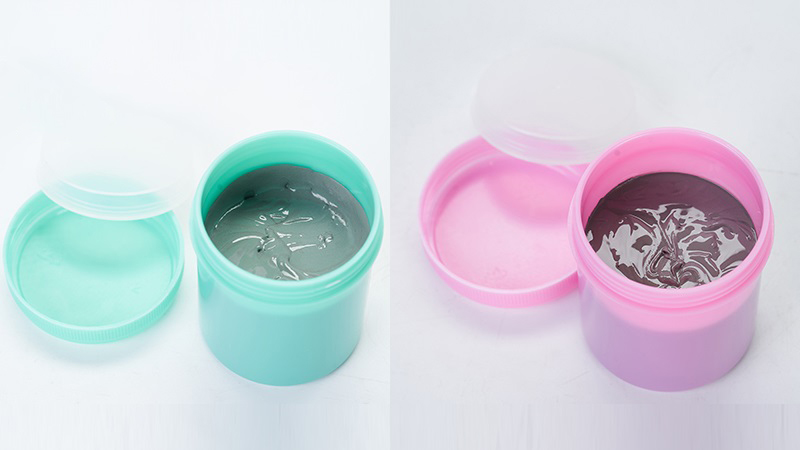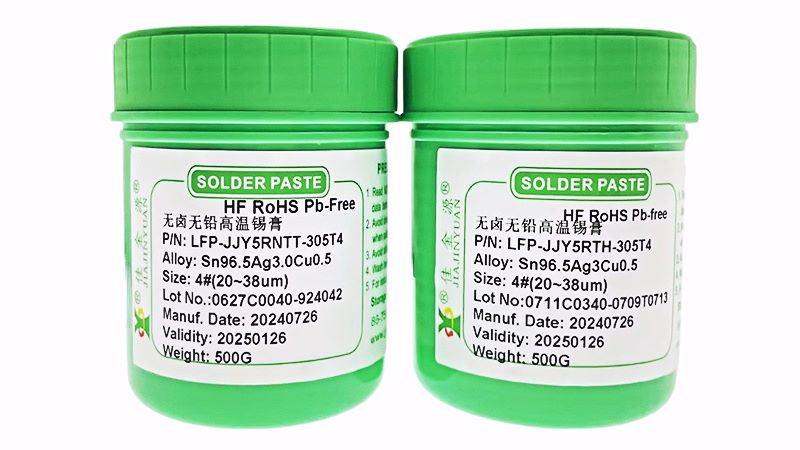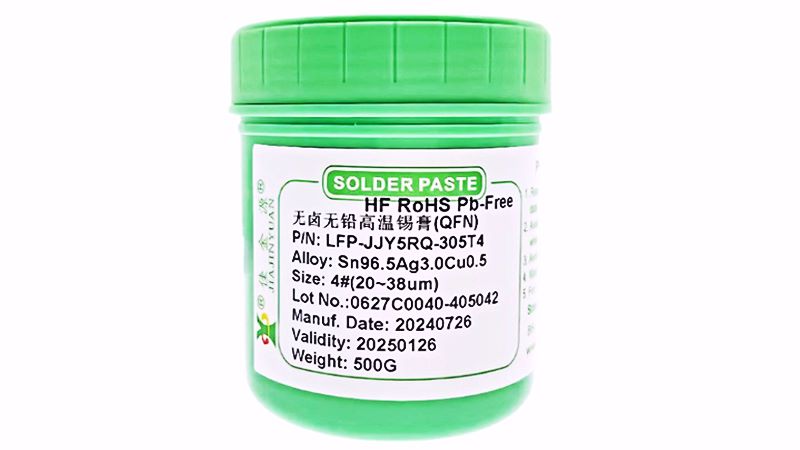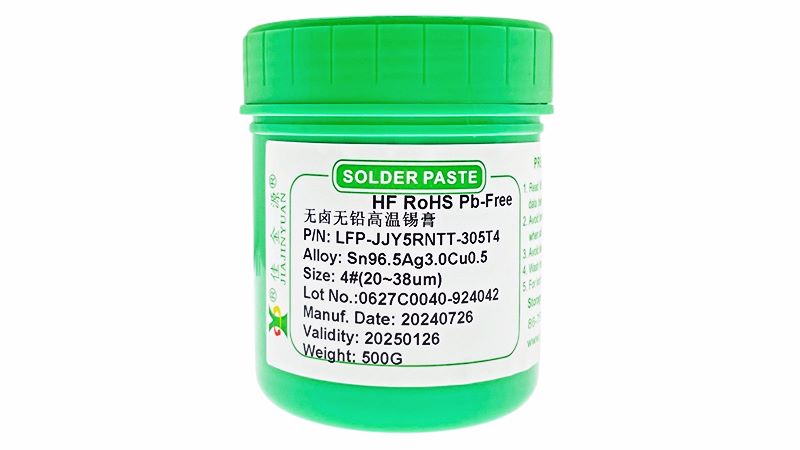Everyone has known what it isLead-free solder paste? Lead-free solder paste is a product specially designed forSMTHalogen-free, lead-free and no-cleaning solder paste designed and manufactured by the processing production line, that is, halogen-free solder paste. Halogenated solder paste refers to solder paste containing halogen elements. Solder paste is a paste-like solid formed by uniformly mixing solder alloy powder and flux carrier system in a certain proportion. The viscosity of solder paste has rheological properties. That is, under the action of shear force, the viscosity decreases to facilitate printing, and after printing, the viscosity recovers. Then, it plays a role in fixing electronic components before re-soldering.

tinThe composition of the ointment:
It is composed of alloy powder and flux.
Flux is composed of activators, binders, wetting agents, solvents, thixotropic agents and other additives, etc.
Alloy types of solder paste:
Metal composition: Silver-containing solder pasteSn62/Pb36/Ag2), without silver solder pasteSn63/ Pb37)Bismuth-containing solder pasteBi14/Sn43/Pb43)And lead-free solder paste(Sn-Ag,Sn-Zn,Sn-BiSeries).
Flux in solder paste
1.Fluxes are classified into three major categories: rosin fluxes, synthetic resin fluxes and water-soluble fluxes.
2.According to the difference in activity, rosin fluxes can be classified as Three types:R Type (rosin flux)RMA Type (weakly active flux) and RA Type (active flux).
The characteristics of the three fluxes are as follows:
3. The role of flux components in solder paste :
Activator: The mechanical and electrical connection of components and circuits
Adhesive: Provides the adhesive required for mounting components
Wetting agent: Adds moisture between the solder paste and the workpiece to be welded
Solvent: Adds welding properties
Thixotropic agent: Improves the thixotropy of solder paste
Other additives: Improve the corrosion resistance of solder paste, the brightness of solder joints and flame retardancy, etc .
Classification of solder paste:
5.1Ordinary rosin cleaning type[pointsRA(ROSIN ACTIVATED andRMA(ROSIN MILDLY ACTIVATED)]
This type of solder paste demonstrates a better "soldering speed" during the soldering process and can ensure an outstanding "soldering effect". After the welding work is completed,PCBThere is relatively a lot of rosin residue on the surface. It can be cleaned with an appropriate cleaning agent. After cleaning, the board surface is bright and free of residue, ensuring that the cleaned board surface has excellent insulation resistance and can pass various electrical function technical tests.
5.2No-cleaning solder paste[NC(NO CLEAN)]
After this kind of solder paste soldering is completed,PCBThe surface of the board is relatively bright with little residue. It can pass various electrical functional skills tests and does not require re-cleaning. While ensuring the welding quality, it shortens the production process and speeds up the production progress.
5.3Water-soluble solder paste[WMA(WATER SOLUBLE PASTES)]
The solder paste produced in the early stage was due to technical reasons.PCBExcessive residue on the board surface leads to unsatisfactory electrical performance, seriously affecting the product quality. At that time, it was often used.CFCUse a cleaning agent for cleaning, becauseCFCIt is detrimental to environmental protection and has been banned in many countries. In order to meet the demands of the market, water-soluble solder paste has emerged. After the soldering work with this type of solder paste is completed, its residue can be washed clean with water, which not only reduces the production cost for customers but also meets the requirements of environmental protection.
The quality of solder paste:
6.1Viscosity
Die bonding solder paste is a thixotropic fluid that can become active under the action of external force. Viscosity is the main characteristic target of die bonding solder paste, and it is an important factor affecting the printing performance: if the viscosity is too high, the die bonding solder paste is not easy to pass through the holes of the template, and the printed graphics are incomplete. The main factors affecting the viscosity of solder paste: The percentage content of tin powder: The higher the alloy content, the greater the viscosity.
6.2Thixotropic index and collapse degree
Die bonding solder paste is a thixotropic fluid. The slump of die bonding solder paste is mainly related to the viscosity and thixotropy of the solder paste. The thixotropic index is high and the slump is small. The thixotropic index is low and the collapse degree is large.
6.3Composition of tin powder and additives
The composition of solder powder, the composition of flux, and the ratio of solder powder to flux are the key parameters that determine the melting point, printability, solderability and solder joint quality of solder paste. It is generally required that the alloy components of tin powder reach eutectic or near-eutectic as much as possible. The ratio of tin powder to flux is indicated by the weight percentage of tin powder in the solder paste.
6.4.The size, shape and distribution of tin powder particles
The size, shape and uniformity of tin powder particles are important parameters affecting the functions of solder paste, and they influence the printability, demolding property and solderability of die bonding solder paste. Solder paste with fine particles has better printability, especially for products with high density and narrow spacing.
6.5The shape of alloy powder
The shape of the alloy powder also affects the printability, demolding property and solderability of the die bonding solder paste. The solder paste composed of spherical particle alloy powder has a relatively low viscosity. After printing, the solder paste pattern is simple to collapse, with good printability and a wide range of applications. It is particularly suitable for high-density narrow-interval screen and metal template printing, and is also applicable to the drop coating process.
Selection of solder paste:
7.1 Alloy composition
The alloy composition of solder paste directly affects the mechanical and electrical functions such as soldering temperature, solderability and solder joints.Generally, in the product manual of solder paste, the product specifications and product features will be noted.BELLCORE AND J-STD The test results can be used to understand solder paste first.The most commonly used alloy components and melting points of solder paste nowadays
note:SAC(SnAgCu)Alloy is inSnAgParticipate on the basis of thatCuAnd it was formed..After comparing the electromechanical functions of the solder joints composed of various alloy formulations,SACAlloys have been recommended by authoritative institutions in Europe, America and Japan due to their relatively balanced performance in various functions. The alloy formula is as followsAg(3%~4%)Cu(0.5%~2%)There are many, among which there are more96.5%Sn,3%Ag,0.5%Cuand95.5%Sn,3.8%Ag,0.7%CuMost.However, the drawback of this formula is that the actual welding temperature needs to be as high as possible245 ℃It is left and right, and the moisture content is not ideal, so a special flux formula needs to be selected.The user needs to evaluate the printability of the solder paste and the reliability of the solder joints based on the changes in the flux formula and the application of specific products.
7.2 The viscosity of solder paste
The viscosity of solder paste can be understood as the resistance to its movement("UnitPa•s")It directly affects the effect of welding.It has low viscosity and good fluidity of solder paste, which is conducive to tin penetration, eliminates the need for washing and saves time. However, the molding is not good and it is prone to bridging;It has high viscosity and large movement resistance, can maintain an excellent solder paste shape, and is more suitable for fine-interval printing. However, it is prone to clogging the mesh and causing insufficient solder.The viscosity of the solder paste changes with the variations of temperature, movement speed and exposure time.Therefore, it is necessary to consider comprehensively and control the viscosity of the solder paste within an appropriate range.
1) The viscosity of solder paste increases as the temperature drops and decreases conversely.The suitable temperature is(25±2.5) ℃For this reason, the temperature of the environment where solder paste is used needs to be controlled.
2) The larger the cross-sectional diameter of the solder paste when printed on the steel screen, the greater the viscosity;Conversely, the smaller the diameter, the lower the viscosity.However, considering that solder paste exposed to the air for too long will deteriorate in quality, it is generally chosen10~15 mmThe diameter of the solder paste rolling.
3) The viscosity of solder paste is inversely proportional to its angular velocity of movement.The greater the printing speed, the smaller the viscosity; conversely, the greater the viscosity.Therefore, the viscosity of the solder paste can be improved by appropriately adjusting the speed of the scraper, and then the printing condition of the solder paste can be improved.The same viscosity will change with the mixing of the solder paste. The viscosity will decrease during the mixing process, but it will return to its original state after a slight stand.
4) The Angle of the scraper can also affect the viscosity of the solder paste.The larger the Angle, the greater the viscosity; conversely, the smaller the viscosity.Generally selected45°or60°Two types of scrapers.
In conclusion, the viscosity of the solder paste selected should match the applied process, and the produced viscosity can also be adjusted by changing the process parameters.When using steel mesh for underprinting, the viscosity of the solder paste should be at800~1 300 Pa•s.Now.0.4PITCHThe viscosity used in it is1 600 Pa•s.
For those who want to know about solder paste, solder paste, low-temperature solder paste, solder wire and solder bar, welcome to consult Shenzhen JJY Industrial Technology Co., LTD. Let's learn and grow together!





 Tel:+86 0755 88366766
Tel:+86 0755 88366766 Phone:+86 18938660310
Phone:+86 18938660310 Email:sales@jjyhanxi.com
Email:sales@jjyhanxi.com Address:13/F,12/F, Building No. B,Qinghu Technology Park,Qingxiang Rd.,Qinghu Community, Longhua Subdistrict,Longhua District,Shenzhen City,GUANGDONG Province,P.R.C.(518027)
Address:13/F,12/F, Building No. B,Qinghu Technology Park,Qingxiang Rd.,Qinghu Community, Longhua Subdistrict,Longhua District,Shenzhen City,GUANGDONG Province,P.R.C.(518027) Guangdong Public Security Backup 44030902002666 name
Guangdong Public Security Backup 44030902002666 name
 WeChat
WeChat WeChat official account
WeChat official account
